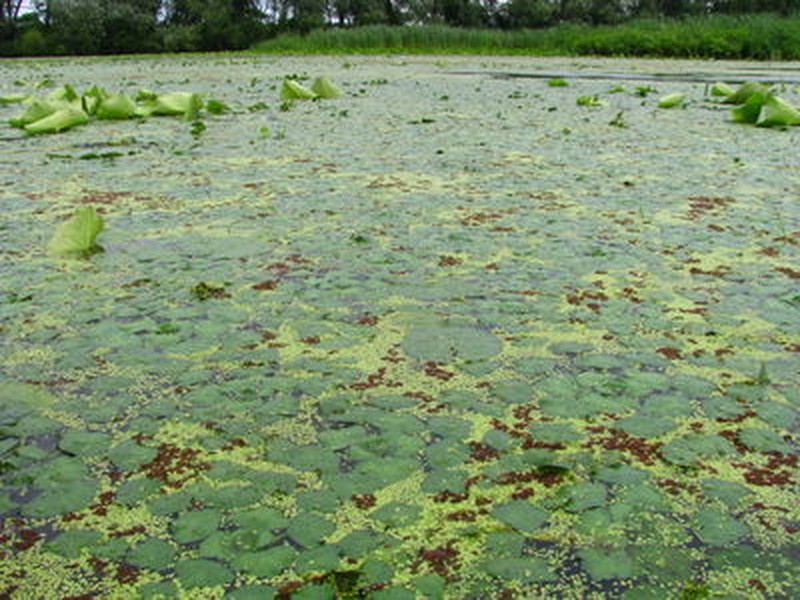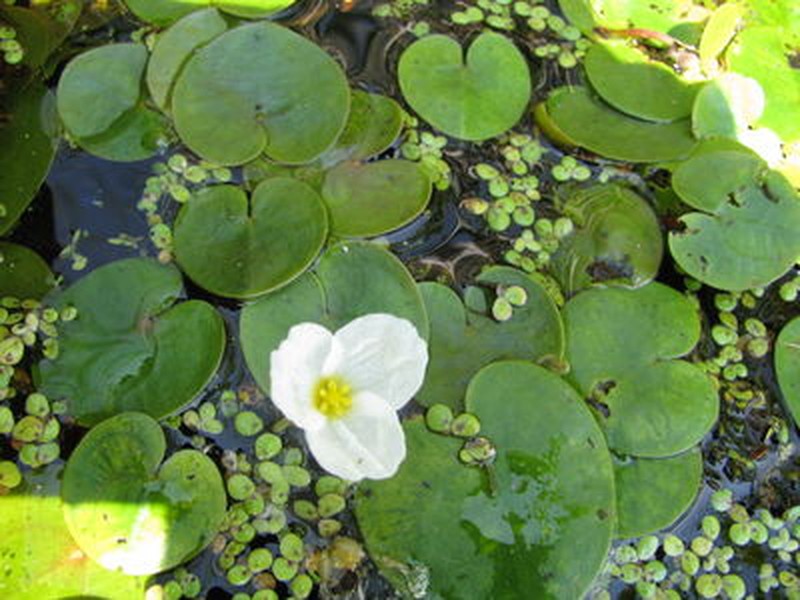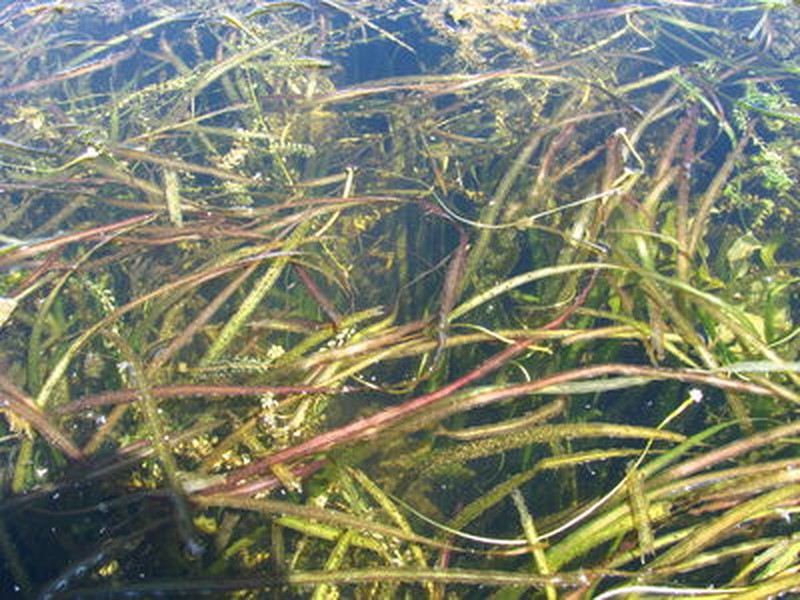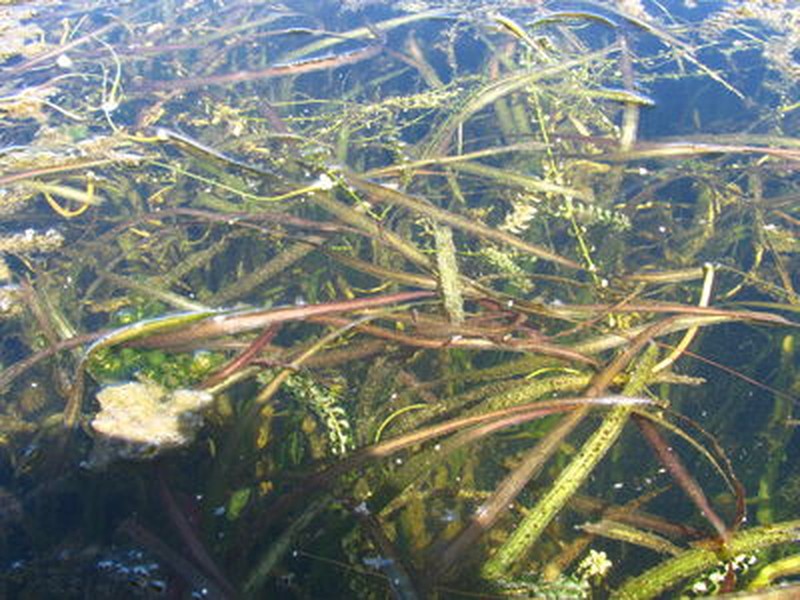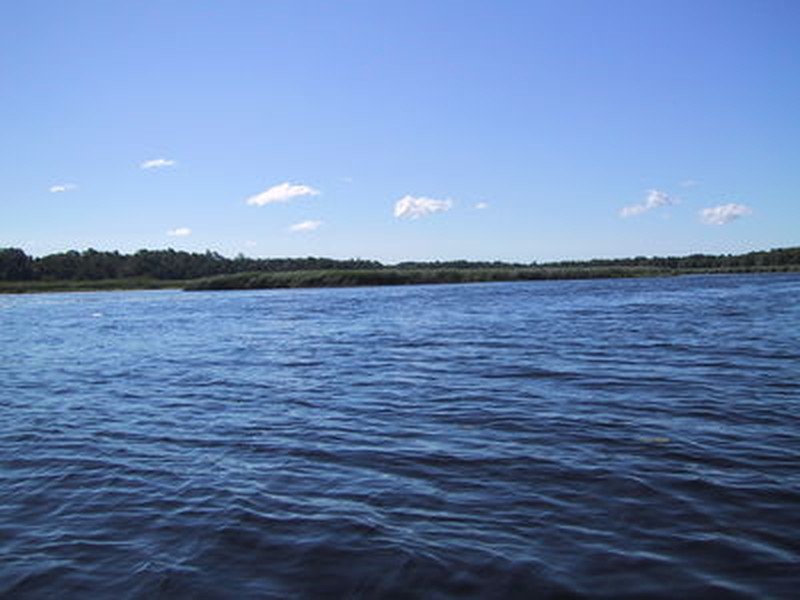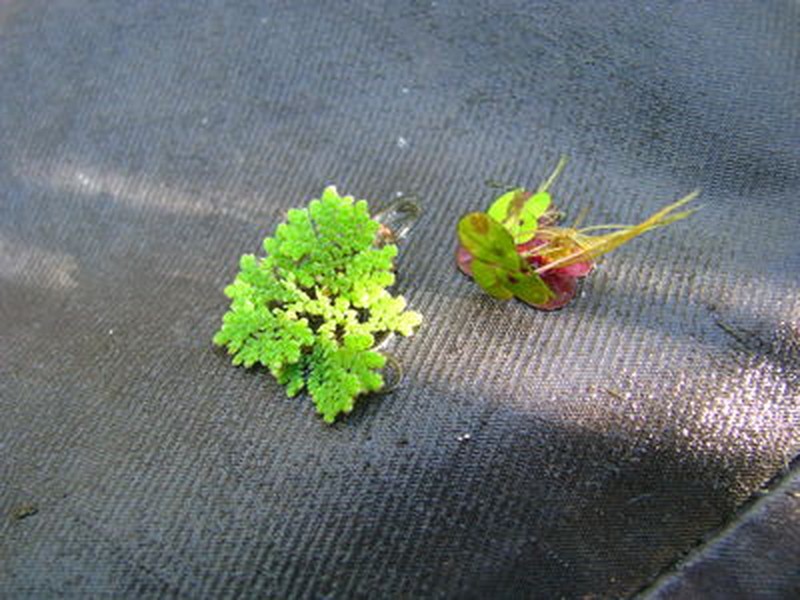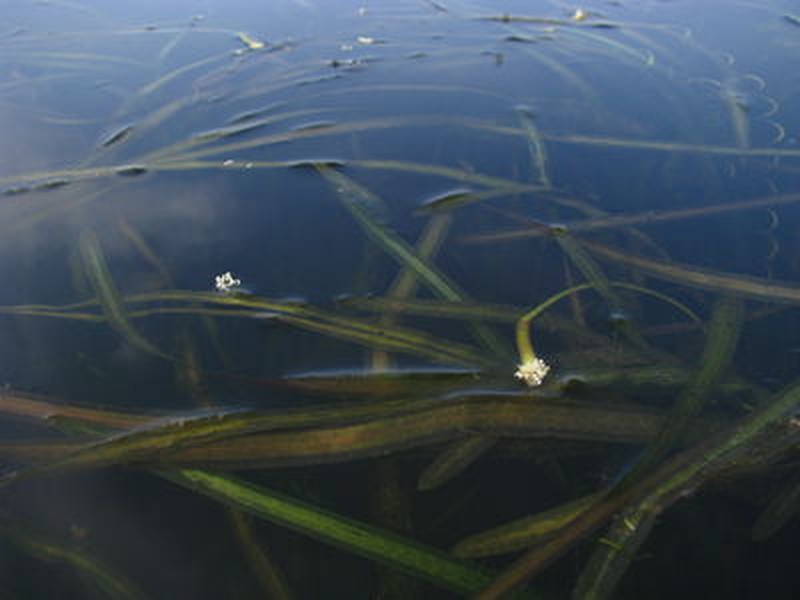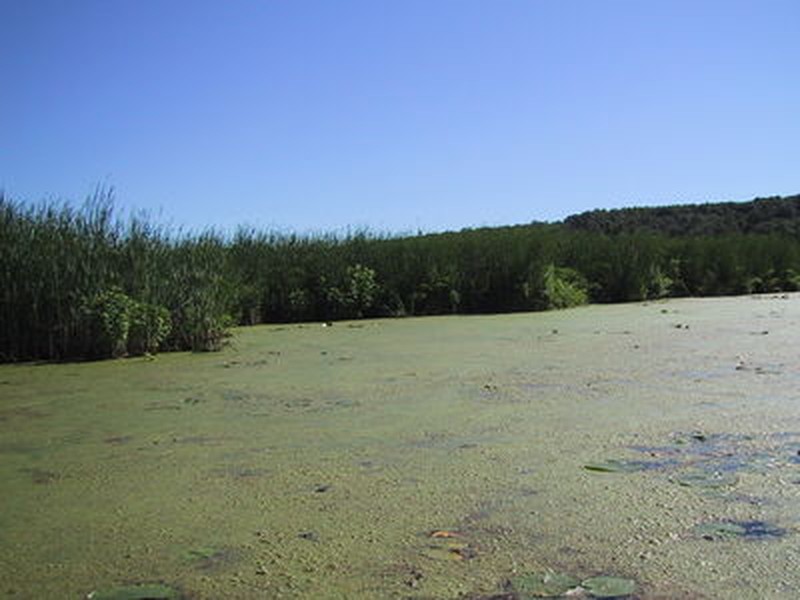Great Lakes Aquatic Bed
- System
- Lacustrine
- Subsystem
- Natural Lakes And Ponds
- State Protection
- Not Listed
Not listed or protected by New York State.
- Federal Protection
- Not Listed
- State Conservation Status Rank
- S3
Vulnerable in New York - Vulnerable to disappearing from New York due to rarity or other factors (but not currently imperiled); typically 21 to 80 populations or locations in New York, few individuals, restricted range, few remaining acres (or miles of stream), and/or recent and widespread declines.
- Global Conservation Status Rank
- G4
Apparently Secure globally - Uncommon in the world but not rare; usually widespread, but may be rare in some parts of its range; possibly some cause for long-term concern due to declines or other factors.
Summary
Did you know?
The submerged aquatic vegetation (SAV) coverage in two NY Great Lakes aquatic beds increased significantly between 1972 and 2002 (Sodus Bay >35% and Chaumont Bay 198% areal increase). In addition, SAV was found at greater water depths in these two bays over that same time period (Sodus Bay from 5.5 to 6.4 m and Chaumont Bay 5.1 to 6.1 m). Researchers think that this increase is likely caused by increased water clarity in Lake Ontario, which could be associated with the implementation of the Great Lakes Water Quality Agreement and the invasion of filter-feeding zebra mussel and quagga mussel (Zhu et al. 2007).
State Ranking Justification
There are probably several hundred occurrences statewide. Few occurrences are presumed to have good viability and are protected on public land or private conservation land. The physical setting of this community is restricted to the barrier bays of Lake Ontario and Lake Erie and includes a few high quality examples. The current trend of this community is probably stable for occurrences on protected land, or declining slightly elsewhere due to moderate threats related to development pressure, invasive aquatic species, and alteration to the natural hydrology.
Short-term Trends
The increase of areal cover of Great Lakes aquatic beds and their expansion into deeper water in New York in recent decades is likely a result of increased water clarity in Lake Ontario, which could be associated with the implementation of the Great Lakes Water Quality Agreement and the invasion of filter-feeding zebra mussel and quagga mussel (Zhu et al. 2007). However, this increase also includes the spread of invasive aquatic plants.
Long-term Trends
Given the persistent physical barrier-bay setting of this community, the number and acres of Great Lakes aquatic beds in New York are probably comparable to historical numbers, but the water quality of several of these beds has likely declined significantly as a result of several human caused disturbances (e.g., nutrient and pollution run-off, invasive species, watershed development, etc.).
Conservation and Management
Threats
Great Lakes aquatic beds are threatened by shoreline development and its associated run-off (e.g., residential, commercial, agricultural, and roads), recreational overuse (e.g., powerboats), and habitat alteration in the adjacent landscape (e.g., pollution run-off, oil spills, and increased impervious surfaces within the watershed). In addition, alteration to the natural hydrology (e.g., dredging of bay inlets for boat access, reduction in water lake level fluctuation from downstream dam) and reduction in water quality (e.g., siltation, turbidity, septic/nutrient run-off) are threats to these aquatic beds. Great Lakes aquatic beds are threatened by the spread of non-native invasive species, such as Eurasian milfoil (Myriophyllum spicatum), European frog’s bit (Hydrocharis morsus-ranae), water chestnut (Trapa natans), curly pondweed (Potamogeton crispus), and zebra mussel (Dreissena polymorpha). There is the potential threat that the use of herbicides to control exotic plants may affect non-target native species.
Conservation Strategies and Management Practices
Where practical, establish and maintain bay shoreline buffer to reduce storm-water, pollution, and nutrient run-off, while simultaneously capturing sediments before they reach the aquatic bed. Buffer width should take into account the erodibility of the surrounding soils, slope steepness, and current land use. If possible, minimize the number and size of impervious surfaces in the surrounding landscape. Avoid habitat alteration within the lake and surrounding landscape. For example, roads should not be routed through the buffer area. Prevent the spread of invasive exotic species into the lake through appropriate direct management, and by minimizing potential dispersal corridors. Great Lakes aquatic beds would likely benefit from actions included in Lakewide Action and Management Plans (or LAMPs) for Lake Erie and Lake Ontario. These plans include actions to assess, restore, protect and monitor the ecosystem health of each Great Lake in New York State.
Development and Mitigation Considerations
When considering road construction and other development activities, minimize actions that will change what water carries and how water travels to Great Lake bays with aquatic beds, both on the surface and underground. Water traveling over-the-ground as run-off usually carries an abundance of silt, clay, and other particulates during (and often after) a construction project. While still suspended in the water, these particulates make it difficult for aquatic animals to find food; after settling to the bottom of the lake, these particulates bury small plants and animals and alter the natural functions of the community in many other ways. Thus, road construction and development activities near Great Lake bays should strive to minimize particulate-laden run-off into this community. Water traveling on the ground or seeping through the ground also carries dissolved minerals and chemicals. Road salt, for example, is becoming an increasing problem both to natural communities and as a contaminant in household wells. Fertilizers, detergents, and other chemicals that increase the nutrient levels in Great Lake bays cause algae blooms and eventually an oxygen-depleted environment where few animals can live. Herbicides and pesticides often travel far from where they are applied and have lasting effects on the quality of the natural community. So, road construction and other development activities should strive to consider: 1. how water moves through the ground, 2. the types of dissolved substances these development activities may release, and 3. how to minimize the potential for these dissolved substances to reach this natural community.
Inventory Needs
Resurvey known occurrences and survey for occurrences statewide to advance documentation of the current stucture, composition, and condition of Great Lakes aquatic beds. A statewide review of the barrier bays of Lake Ontario and Lake Erie is desirable. Continue searching for aquatic beds in good condition (A- to AB-ranked). Review and incorporate data on occurrences in NY gathered by the International Joint Commission’s (IJC) Great Lakes- St. Lawrence Adaptive Management (GLAM) Committee. Confirm if this community is present in Lake Champlain and determine its extent down the St. Lawrence River.
Research Needs
Need research on how Great Lakes aquatic beds change over time in response to fluctuating water levels in Lake Ontario. Further research is needed at additional sites as a follow-up to Zhu et al. (2007) on the impacts of invasive aquatic plants and non-native mussels to aquatic beds.
Rare Species
Range
New York State Distribution
Restricted to the Great Lakes Ecoregion in direct association with Lake Ontario and Lake Erie. The range extends northeast in association with the outlet of Lake Ontario downstream along the upper Saint Lawrence River to about Chippewa Bay.
Global Distribution
This community is restricted to the Great Lakes basin in direct association with the Great Lakes. This range spans north and west to Lake Superior south to Lake Erie and east to the outlet of Lake Ontario.
Best Places to See
- Irondequoit Bay (Monroe County)
- North Pond (Oswego County)
- Chippewa Bay (St. Lawrence County)
- Braddock Bay (Monroe County)
- Sodus Bay (Wayne County)
- Kings Bay (Clinton County)
Identification Comments
General Description
Great Lakes aquatic beds are aquatic communities located in the protected shoals of the Great Lakes or Lake Champlain. They occur in quiet bays that are protected from extreme wave action by islands, shoals or barrier bars, and typically support large areas of “weeds” or aquatic macrophytes. These bays may freeze over in winter and become inversely stratified (coldest water at the surface). They are warm, mesotrophic, and alkaline. Substrate can vary among sand, silt, muck, and rock. Two variants are known: 1) typical “aquatic beds” with abundant submerged aquatic vegetation; and 2) unvegetated or very sparsely-vegetated bays and coves.
Characters Most Useful for Identification
Great Lakes aquatic beds are best developed in the barrier bays of Lake Ontario and typically dominated by submerged aquatic vegetation (SAV) and floating-leaved aquatic plants. Bays with SAV should be deep enough to have little to no emergent vegetation, but not too deep to exclude submergent vegetation. Typical maximum depth is about 6 m (20 feet). Water depth is generally shallow enough to be characterized as a winter-stratified monomictic lake-type.
Elevation Range
Known examples of this community have been found at elevations between 221 feet and 250 feet.
Best Time to See
The vegetation of Great Lakes aquatic beds is most evident during the summer growing season and best observed from a boat.
Great Lakes Aquatic Bed Images
Classification
International Vegetation Classification Associations
This New York natural community encompasses all or part of the concept of the following International Vegetation Classification (IVC) natural community associations. These are often described at finer resolution than New York's natural communities. The IVC is developed and maintained by NatureServe.
- Flatstem Pondweed - Coon's-tail - Canadian Waterweed Southern Great Lakes Shore Aquatic Vegetation (CEGL005152)
NatureServe Ecological Systems
This New York natural community falls into the following ecological system(s). Ecological systems are often described at a coarser resolution than New York's natural communities and tend to represent clusters of associations found in similar environments. The ecological systems project is developed and maintained by NatureServe.
- Great Lakes Freshwater Estuary and Delta (CES202.033)
- Northern Great Lakes Coastal Marsh (CES201.722)
Characteristic Species
-
Nonvascular plants
- Chara vulgaris
- Cladophora sp.
-
Floating-leaved aquatics
- Lemna trisulca (star duckweed)
-
Submerged aquatics
- Ceratophyllum demersum (common coon-tail)
- Elodea canadensis (Canada waterweed)
- Heteranthera dubia (water star-grass)
- Myriophyllum spicatum (Eurasian water milfoil)
- Najas flexilis (common water-nymph, common naiad)
- Potamogeton friesii (Fries's pondweed)
- Potamogeton gramineus (grass-leaved pondweed)
- Potamogeton pusillus (common narrow-leaved pondweed)
- Potamogeton richardsonii (Richard's pondweed)
- Stuckenia pectinata (Sago pondweed)
- Utricularia vulgaris ssp. macrorhiza (greater bladderwort)
- Vallisneria americana (water-celery, tape-grass)
- Zannichellia palustris (horned pondweed)
-
Unvegetated
- bluegill (Lepomis macrochirus)
- brown bullhead (Ameiurus nebulosus)
- Iowa darter (Etheostoma exile)
- largemouth bass (Micropterus salmoides)
- longnose gar (Lepisosteus osseus)
- muskellunge (Esox masquinongy)
- northern pike (Esox lucius)
- redfin pickerel (Esox americanus)
- smallmouth bass (Micropterus dolomieu)
- tadpole madtom (Noturus gyrinus)
- threespine stickleback (Gasterosteus aculeatus)
- white perch (Morone americana)
- white sucker (Catostomus commersoni)
Similar Ecological Communities
- Deep emergent marsh
(guide)
Although Great Lakes aquatic beds and deep emergent marshes share many floating-leaved and submerged aquatic plants, Great Lakes aquatic beds typically lack emergent vegetation. Whereas, deep emergent mashes are dominated by several emergent aquatic plants with up to 85% cover. Deep emergent marsh water levels fluctuate from 0.15 m to 2 m occaisionally exposing the substrate, while Great Lakes aquatic beds are permanently flooded up to 6 m deep.
- Freshwater subtidal aquatic bed
While the two aquatic bed communities share several species, such as tape grass or wild celery (Vallisneria americana), coonntail (Ceratophyllum demusum), and the invasive Eurasian milfoil (Myiophyllum spicatum); freshwater subtidal aquatic beds are found in tidal rivers like the Hudson River, and Great Lakes aquatic beds are found in a barrier-bay setting of a Great Lake like Lake Ontario.
- Great Lakes deepwater community
(guide)
The Great Lakes deepwater community includes the deeper, unvegetated open waters of Lake Ontario (244 m max. depth) and Lake Erie (64 m max. depth) and excludes the shallower (<7 m deep) back-barrier bays with abundant floating-leaved and submerged aquatic plants that are characteristic of Great Lakes aquatic beds.
- Great Lakes exposed shoal
Great Lakes aquatic beds are typically found in a barrier-bay setting, ideally with islands, shoals, or barrier bars separating the bay from associated Great Lakes deepwater areas. Whereas, Great Lakes exposed shoals have direct contact, and greater wave exposure, to the Great Lakes deepwater community. In addition, Great Lakes exposed shoals are sparsely vegetated with submerged aquatic vegetation (SAV) compared to Great Lakes aquatic beds that often have abundant SAV.
- Marine back-barrier lagoon
Both communities are similar in that they occur in back-barrier bay settings, but are very different in tidal regime, salinity, and dominant species. Great Lakes aquatic beds are a freshwater, non-tidal community dominated by freshwater plants and animals adjacent to a Great Lake, while marine back-barrier lagoons are located in shallow polyhaline (18 to 30 ppt salinity) waters of tidal embayments adjacent to the ocean.
- Winter-stratified monomictic lake
(guide)
Both communities are similar in that they both have only one period of mixing each year, freeze over and become inversely stratified in the winter (coldest water at the surface), and share numerous floating-leaved and submerged aquatic plants, such as water stargrass (Heteranthera dubia), coontail (Ceratophyllum demersum), waterweeds (Elodea spp.), common naiad (Najas flexilis). water celery or tape grass (Vallisneria americana), and pondweeds (Potamogeton pusillus, P. richardsonii). However, Great Lakes aquatic beds are found in a barrier-bay setting of a Great Lake like Lake Ontario. Winter-stratified monomictic lakes are not associated with the Great Lakes.
Vegetation
Percent cover
This figure helps visualize the structure and "look" or "feel" of a typical Great Lakes Aquatic Bed. Each bar represents the amount of "coverage" for all the species growing at that height. Because layers overlap (shrubs may grow under trees, for example), the shaded regions can add up to more than 100%.
Additional Resources
References
Clausen, R.T. 1940. Aquatic vegetation of the Lake Ontario watershed. In: A biological survey of the Lake Ontario watershed, including all waters from Little Sandy Creek westward except the Genesee and Oswego River systems; supplemental to 29th annual report, Biological survey report XVI. pp 167-23.1
Edinger, G. J., D. J. Evans, S. Gebauer, T. G. Howard, D. M. Hunt, and A. M. Olivero (editors). 2014. Ecological Communities of New York State. Second Edition. A revised and expanded edition of Carol Reschke’s Ecological Communities of New York State. New York Natural Heritage Program, New York State Department of Environmental Conservation, Albany, NY. https://www.nynhp.org/ecological-communities/
Edinger, Gregory J., D.J. Evans, Shane Gebauer, Timothy G. Howard, David M. Hunt, and Adele M. Olivero (editors). 2002. Ecological Communities of New York State. Second Edition. A revised and expanded edition of Carol Reschke's Ecological Communities of New York State. (Draft for review). New York Natural Heritage Program, New York State Department of Environmental Conservation. Albany, NY. 136 pp.
New York Natural Heritage Program. 2024. New York Natural Heritage Program Databases. Albany, NY.
Reschke, Carol. 1990. Ecological communities of New York State. New York Natural Heritage Program, New York State Department of Environmental Conservation. Latham, NY. 96 pp. plus xi.
Zhu, Bin, D. G. Fitzgerald, S. B. Hoskins, L. G. Rudstam, C. M. Mayer, and E. L. Mills. 2007. Quantification of Historical Changes of Submerged Aquatic Vegetation Cover in Two Bays of Lake Ontario with Three Complementary Methods. Journal of Great Lakes Research 33(1), 122-135.
Links
- Braddock Bay Wildlife Management Area (NYS DEC)
- Great Lakes (NYS DEC)
- Great Lakes Water Quality Agreement (GLWQA)
- Lake Shore Marshes Wildlife Management Area (NYS DEC)
- Quantification of Historical Changes of Submerged Aquatic Vegetation Cover in Two Bays of Lake Ontario with Three Complementary Methods (Zhu et al. 2007)
- Satellite-Derived Great Lakes Submerged Aquatic Vegetation Classification Map.
- Tracking Coastal Wetland Response to Changing Great Lakes Water Levels
About This Guide
This guide was authored by: Gregory J. Edinger
Information for this guide was last updated on: February 5, 2024
Please cite this page as:
New York Natural Heritage Program. 2024.
Online Conservation Guide for
Great Lakes aquatic bed.
Available from: https://guides.nynhp.org/great-lakes-aquatic-bed/.
Accessed July 27, 2024.
